
This is a placeholder text
Group text
by Blitzen on 26 June 2014 - 12:06
One standard or a dozen, what difference would it make when the judges ignore it all anyway? Heads like we are seeing on the V and Va dogs are not the results of the way the FCI standard is worded, its the results of the judges decisions. It's very clear to most reasonable people that the standard is not asking for a GSD that looks like a cross between an Akita and and St Bernard.
Maybe it's the desire to produce more defined male sex characteristics in the SV dogs that has led to where those dogs are today? I've mentioned this before, the females seem to still have correct heads, more athleticism, and are sounder overall. I haven't been to any big SV shows for a while; I don't see many of these overdone heads at the local shows, but it may only be a matter of time.
by Blitzen on 26 June 2014 - 12:06
Head
The head is noble, cleanly chiseled, strong without coarseness, but above all not fine, and in proportion to the body. The head of the male is distinctly masculine, and that of the bitch distinctly feminine.
The expression keen, intelligent and composed. Eyes of medium size, almond shaped, set a little obliquely and not protruding. The color is as dark as possible. Ears are moderately pointed, in proportion to the skull, open toward the front, and carried erect when at attention, the ideal carriage being one in which the center lines of the ears, viewed from the front, are parallel to each other and perpendicular to the ground. A dog with cropped or hanging ears must be disqualified.
Seen from the front the forehead is only moderately arched, and the skull slopes into the long, wedge-shaped muzzle without abrupt stop. The muzzle is long and strong, and its topline is parallel to the topline of the skull. Nose black. A dog with a nose that is not predominantly black must be disqualified. The lips are firmly fitted. Jaws are strongly developed. Teeth --42 in number--20 upper and 22 lower--are strongly developed and meet in a scissors bite in which part of the inner surface of the upper incisors meet and engage part of the outer surface of the lower incisors. An overshot jaw or a level bite is undesirable. An undershot jaw is a disqualifying fault. Complete dentition is to be preferred. Any missing teeth other than first premolars is a serious fault.
by Blitzen on 26 June 2014 - 12:06
Head
The head is wedge-shaped, and in proportion to the body size (length about 40 % at the height at the withers), without being plump or too elongated, dry in the overall appearance and moderately broad between the ears. Seen from the front and side, the forehead is only slightly arched and without any or with only a slightly indicated middle furrow.
The ratio from the cranial region to the facial region is 50 % to 50 %. The width of the cranial region more or less corresponds to the length of the cranial region. The cranial region (seen from above) tapers evenly towards the nasal bridge with gradually sloping, not sharply depicted stop in the wedge-shaped facial region (foreface) of the head. Upper and lower jaws are powerfully developed.
The nasal dorsum is straight, any dip or bulge is undesirable. The lips are taut, close well and are of dark colouring.
The nose must be black.
The teeth must be strong, healthy and complete (42 teeth according to the dental formula). The German Shepherd Dog has a scissor bite, i.e. the incisors must interlock like scissors, whereby the incisors of the upper jaw overlap those of the lower jaw. Occlusal overlay, overbite and retrusive occlusion as well as larger spaces between the teeth (gaps) are faulty. The straight dental ridge of the incisors is also faulty. The jaw bones must be strongly developed so that the teeth can be deeply embedded in the dental ridge.
The eyes are of medium size, almond-shaped, slightly slanted and not protruding. The colour of the eyes should be as dark as possible. Light, piercing eyes are undesirable since they impair the dog’s impression.
by SitasMom on 26 June 2014 - 16:06
i agre that all judges need to actually read the standard once in a while, preferrable before each show.
and also be required to take refresher classes at least once a year with the main national judge.
and the top 10% of dogs that win should have photos sent to the main judge for review and accountability.
IMO, this would "fix" many of the personal preference problems that judges tend to show.......
Each part of the dogs should be discussed, including denoted photos, judges should have a folder of photos denoted videos to show exactly what they are supposed to recognize as correct. And be forced to judge that way.
I've heard too many times, "it all depends on what the judge likes" & "you have to pick the judge that likes your type of dog".
by Abby Normal on 26 June 2014 - 17:06
Sitasmom
Sounds good, but......if the national judge is operating on the same plane as Schweikert - what chance does anyone have. I can only liken it to an anorexic who instead of seeing a skeleton when she looks in the mirror sees a grossly obese apparition and not what it really there.
This is the PDE blog, followed by the full article, both copied from the PDE blog. Jaw dropping in it's irony.
My heart skipped a small beat this morning when *** sent me an article promising:
"An excellent article by a leading German SV Judge and Kormeister on German Shepherd Dog (GSD) Hind angulation and unsoundness."Hurrah! They've realised the error of their ways!
I clicked on the link. It told me that the breed suffered from "over typification, that is, over-angulation in the region of the hindquarter."
Yes, yes!
It went on: "Anyone who still do not wish to face this truth, is sinning, transgressing, against the working dog characteristics of our breed!"
Finally!
It urged: "It is high time, that we faced this criticism and do not ignore it any further, or even dismiss it as the idle talk of some who criticise the German Shepherd with ill intent.
Bravo!
It even nicks a graphic of a horse that's done the rounds on the internet showing what happens if you give a horse a modern GSD show-line shape.
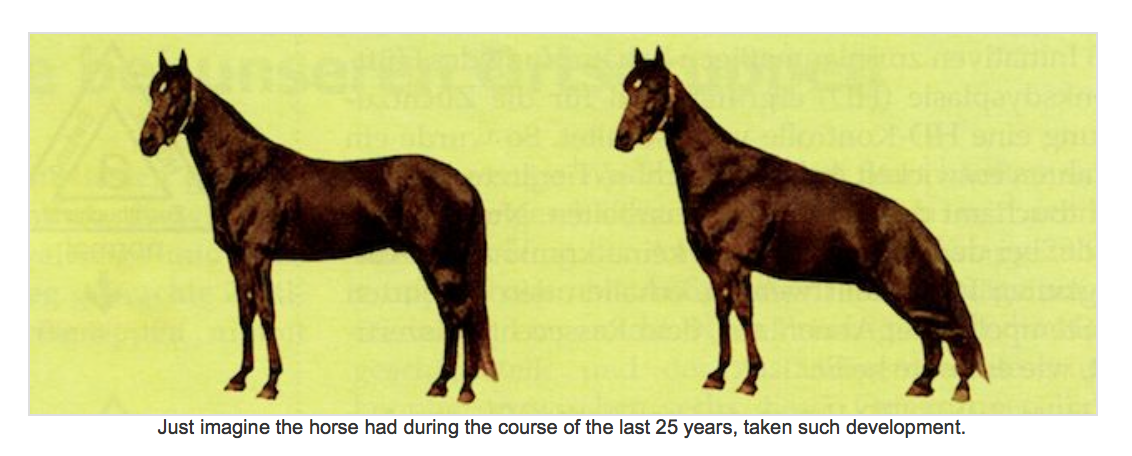
Absolutely! It then pulls out some recent GSD rear ends and illustrates the problem.

Oh, isn't this great?
And finally, our Champion GSD reformer gives us a picture of the dog that he thinks has the perfect angulation. Tah-daaah!
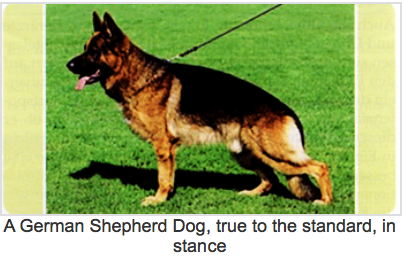
Article by Leonhard Schweikert - translated20/06/2014 Many thanks to Honey Gross-Richardson for doing this translation for my website. Reforms with a Good Eye, Part 2 Leonhard Schweikert The author of this contribution is: In the January issue of the SV Zeitung, the author has dealt with up to date, modern structures for the various breed issues, and proposed an identity pass for the German Shepherd Dog. The size problem of our dogs too, an alternative, digital measuring device as a step towards more objective measurements, as well as a three Judges system for the show scene were chosen as a theme. In his present article, Leonhard Schweikert deals with the over – typification especially in the area of the hindquarter and the possibility of the latest up to date X-raying diagnostics. The Cynological long time favourite: Hindquarter angulation and hock joints As ever before, a considerable problem in our German Shepherd Dog population, is the over-typification, that is, over-angulation in the region of the hindquarter. The problem should be viewed as more serious than for instance the size, for in comparison with the over-angulated dog, the large dog definitely still has working dog qualities. These are clearly and definitely denied to the over-angulated dog with an instability of the hindquarter! Anyone who still do not wish to face this truth, is sinning, transgressing, against the working dog characteristics of our breed! To recognize the effect caused by this over-angulation, one does not have to be an expert: the exaggerated sloping back-line that we are constantly being reproached for by the public, and against which we find it very difficult to find a counter argument. This development has been gossipped about for years. Some speak of the “Porsche Design” others call it the steeply sloping rear end. It is high time, that we faced this criticism and do not ignore it any further, or even dismiss it as the idle talk of some who criticise the German Shepherd with ill intent. What does it say in the Breed Standard: “ The topline flows from the set on of neck over the high, long wither, and over the straight back to the slightly sloping croup without noticeable break. “ And at a different place, under the aspect limbs – hindquarter: “ The position of the hind legs is slightly set back, where the hind-legs viewed from the rear, stand parallel to each other. Upper thigh and lower thigh are of approximately equal length and form an angle of ca. 120 degrees, the thighs are strong and well muscled” ( Bold type by the author) The development of the Depth of Hindquarter 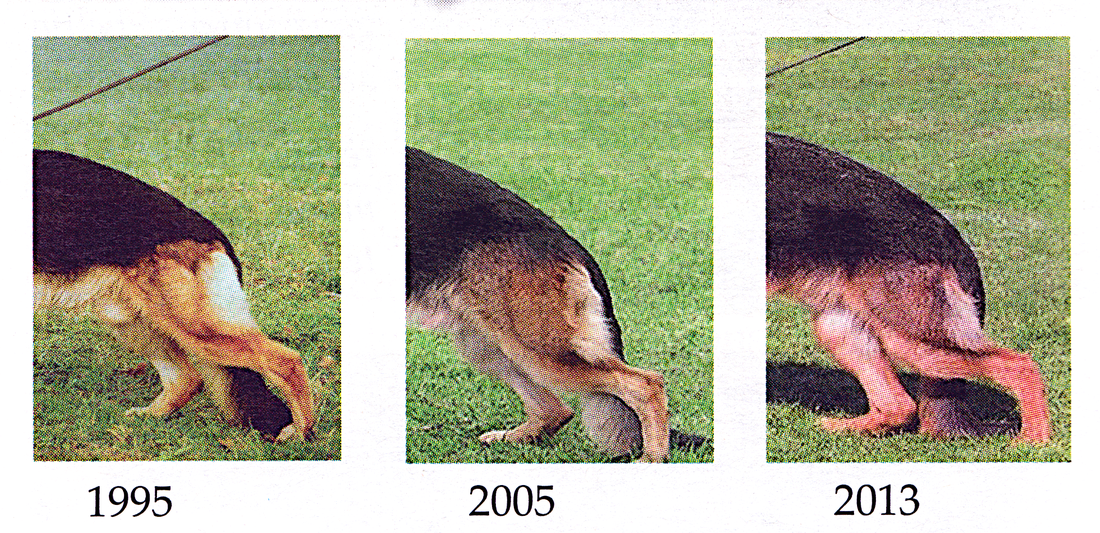
Naturally not the entire German Shepherd Dog population is affected by this, however there are enough top dogs with this genetic disposition, that are apart from this, still heavily used at stud as well, and dominantly pass on this characteristic. For clarification of the problematic situation, a comparison with horse breeding is definitely appropriate: When the founder of the breed, Rittmeister Max von Stephanitz created The Standard of the German Shepherd Dog over 100 years ago, the horse must have been his model. At that early point in time already, there were thousands of years of experience of the breeding of horses as a working animal. The horse was knows as the helper of man and indispensable in everyday life. Beside the cattle and pig breeding, breeding of sheep was a huge economics factor in the 18th and well into the 19th century for producing meat and wool. For the herding of large herds of sheep, a useful working animal was needed. One could not fall back on the horse, as it was not suitable for herding. At best, in huge pastures, the horse could be used to ride the boundaries, but it was practically impossible to drive and direct the herd with horse and rider. So an animal was needed, with the enduring properties of a horse, in order to assist the Shepherds in their work. 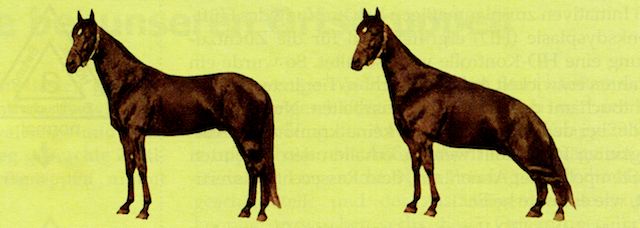
Just imagine the horse had during the course of the last 25 years, taken such development. Von Stephanitz took a medium sized dogs as the model and created his desired anatomy practically as though creating a blue print at the drawing board, derived from the anatomy of the horse. He had to be enduring, to be able to move as herding dog for hours at a medium speed. This prerequisite could only be met by the typical trotter structure. The anatomical virtues that made the horse so useful to man, in his work, the German Shepherd Dog should possess too. The structural proportions, (not the size) the angulations and many other useful features, were taken as the targeted objective, from the horse, and applied to the dog. Of special importance of the features adapted from the horse, is the hindquarter, for every movement is initiated by the hindquarter and transmitted over the back, to the forehand. 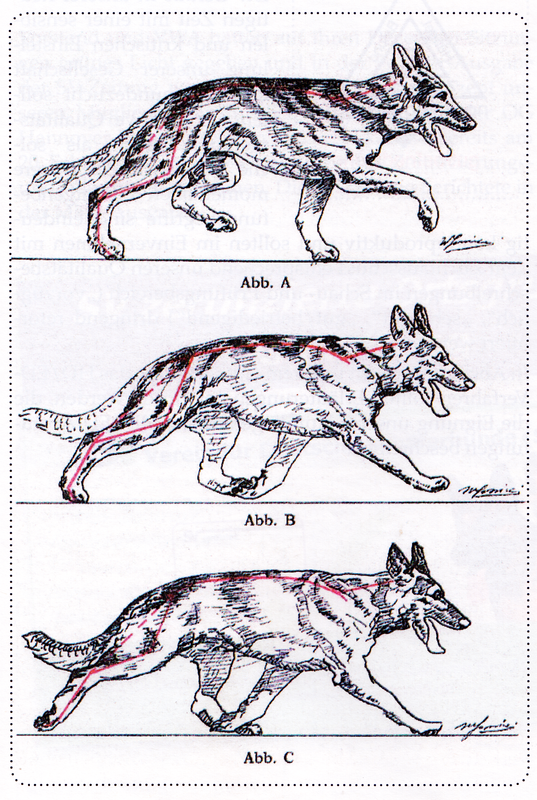
To summarize it is found, that too much or too little, that is over or under – in short, any exaggeration of anatomy will negatively impact on the health of the animal and be detrimental to its mode of locomotion, its movement. Only the anatomical features given in the breed standard give, especially in working dog breeding, the guarantee that with a minimal exertion of power an optimum of movement and endurance can be attained, and that well into a ripe old age, good health, fitness and willingness to work can be maintained. |
by Morton Goldfarb on 26 June 2014 - 20:06
Great article by Schweikert and thanks for posting this!!!
Perhaps the readers know but perhaps not the back is straight if the true definition of the back is observed--that represents the space between the end of the thoracic vertebrae and the beginning of the sacral vertebrae.
Too many refer to the back as the topline-overline in German--that is what it says the overline NOT the back.The overline is gradually sloping with only gentle sloping curves to end at the pelvic conclusion.
The illustrations you show are excellent examples from the book by the italian authors Bonnetti and Gorreriwhich was published in 1987 (I think?)
You did not show the great example of a standing bitch with a super overline!!!
I have the original plates of the drawings courtesy of the SAS WITH RIGHTS TO PUBLISH IN ENGLISH.
I had it translated by an Italian language professor and would like to publish if the English speaking crowd would like and there was enough interest to compensate for the cost.
So bottom line --the overline is not straight but a series of gentle curves and the proportions of whither-back and croup are 1 to 1 to 1.
Thanks
Morton Goldfarb and AKC judge presently and Ful SV Judge (judge in Germany) until I turned 70- ad Judge according to the world standard which is the same for theAKC as well as theSV
by SitasMom on 26 June 2014 - 21:06
Mr. Goldfarb,
"The upper line runs from the base of the neck via the high, long withers and via the straight back towards the slightly sloping croup, without visible interruption. The back is moderately long, firm, strong and well-muscled. The loin is broad, short, strongly developed and well-muscled. The croup should be long and slightly sloping (approx 23° to the horizontal) and the upper line should merge into the base of the tail without interruption."
I have seen that the "topline" is comprised of Withers, Back, Loin and Croup.
If the back is straight, then wouldn't there would most definately be a visible interuption when the croup turns to 23^?
"straight back "towards" the slightly sloping croup........is "towards" refering to the Loin area?
by SitasMom on 26 June 2014 - 21:06
Abby, that is why the national club should most definately choose the head national judge very carefully!
by Abby Normal on 26 June 2014 - 22:06
Yes, it was a great article....but did some people miss the irony in that the dog he finally illustrates as correct and ideal to the standard exhibits all the defects (overly deep angulation etc, that he was saying need to be corrected. The final wording on the PDE blog after his revealing of the 'correct' dog was 'bang head against wall'. I can't say it any better.
by Blitzen on 27 June 2014 - 00:06
Body - The upper line runs from the base of the neck via the high, long withers and via the straight back towards the slightly sloping croup, without visible interruption. The back is moderately long, firm, strong and well-muscled. The loin is broad, short, strongly developed and well-muscled. The croup should be long and slightly sloping (approx 23° to the horizontal) and the upper line should merge into the base of the tail without interruption.
Contact information Disclaimer Privacy Statement Copyright Information Terms of Service Cookie policy ↑ Back to top








